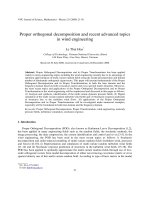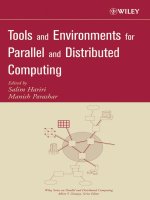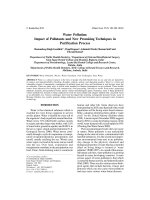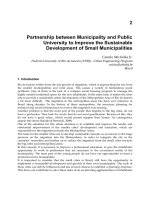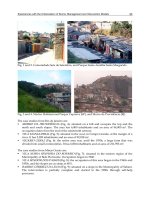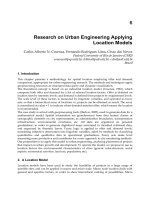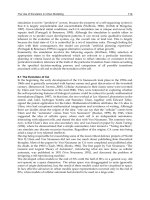Parallel and distributed computing techniques in biomedical engineering
Bạn đang xem bản rút gọn của tài liệu. Xem và tải ngay bản đầy đủ của tài liệu tại đây (946.76 KB, 153 trang )
PARALLEL AND DISTRIBUTED COMPUTING
TECHNIQUES IN BIOMEDICAL ENGINEERING
CAO YIQUN
(B.S., Tsinghua University)
A THESIS SUBMITTED
FOR THE DEGREE OF MASTER OF ENGINEERING
DEPARTMENT OF ELECTRICAL AND COMPUTER ENGINEERING
AND
DIVISION OF BIOENGINEERING
NATIONAL UNIVERSITY OF SINGAPORE
2005
Declaration
The experiments in this thesis constitute work carried out by the candidate
unless otherwise stated. The thesis is less than 30,000 words in length, exclusive of
tables, figures, bibliography and appendices, and complies with the stipulations set
out for the degree of Master of Engineering by the National University of Singapore.
Cao Yiqun
Department of Electrical and Computer
Engineering
National University of Singapore
10 Kent Ridge Crescent, Singapore 119260
National University of Singapore
i
Acknowledgments
I would like to express sincere gratitude to Dr. Le Minh Thinh for his guidance
and support. I thank him also for providing me an opportunity to grow as a research
student and engineer in the unique research environment he creates.
I have furthermore to thank Dr. Lim Kian Meng for his advice and administrative
support and contribution to my study and research.
I am deeply indebted to Prof. Prof. Nhan Phan-Thien whose encouragement as
well as technical and non-technical advices have always been an important support
for my research. Special thanks to him for helping me through my difficult time of
supervisor change.
I would also like to express sincere thanks to Duc Duong-Hong for helping me
through many questions regarding biofluid and especially fiber suspensions
modelling.
Most importantly, my special thanks to my family and my girlfriend. Without
your support, nothing could be achievable.
National University of Singapore
ii
Table of Contents
Chapter 1 Introduction...................................................................................1
1.1 Motivation.............................................................................................................. 2
1.2 Thesis Contributions .............................................................................................. 5
1.3 Thesis Outline ........................................................................................................ 8
Chapter 2 Background .................................................................................10
2.1 Definition: Distributed and Parallel Computing .................................................. 10
2.2 Motivation of Parallel Computing ....................................................................... 11
2.3 Theoretical Model of Parallel Computing ........................................................... 14
2.4 Architectural Models of Parallel Computer ......................................................... 15
2.5 Performance Models of Parallel Computing Systems ......................................... 21
2.6 Interconnection Schemes of Parallel Computing Systems .................................. 27
2.7 Programming Models of Parallel Computing Systems........................................ 31
Chapter 3 Overview of Hardware Platform and Software Environments
for Research in Computational Bioengineering ..........................................34
3.1 Hardware Platform ............................................................................................... 34
3.2 Software Environments for Parallel Programming .............................................. 40
Chapter 4 Parallel Fiber Suspensions Simulation .......................................45
4.1 An Introduction to the Fiber Suspensions Simulation Problem........................... 46
National University of Singapore
iii
4.2 Implementing the Parallel Velocity-Verlet Algorithm using Conventional
Method ....................................................................................................................... 48
4.3 Performance Study of Conventional Implementation.......................................... 52
4.4 Communication Latency and the Number of Processes ...................................... 55
4.5 Implementing the Parallel Fiber Suspensions Simulation with Communication
Overlap....................................................................................................................... 68
4.6 Results.................................................................................................................. 77
4.7 Conclusion ........................................................................................................... 85
Chapter 5 Parallel Image Processing for Laser Speckle Images .................87
5.1 Introduction to Laser Speckle Imaging Technique .............................................. 87
5.2 Previous Work...................................................................................................... 96
5.3 Parallelism of mLSI Algorithm............................................................................ 99
5.4 Master-worker Programming Paradigm............................................................. 100
5.5 Implementation .................................................................................................. 103
5.6 Results and Evaluation....................................................................................... 119
5.7 Conclusion ......................................................................................................... 127
Chapter 6 Conclusions and Suggestions for Future Work.........................129
6.1 Conclusions ........................................................................................................ 129
6.2 Areas for Improvement ...................................................................................... 131
6.3 Automated Control Flow Rescheduling............................................................. 131
6.4 Programming Framework with Communication Overlap.................................. 133
6.5 Socket-based ACL Implementation ................................................................... 134
National University of Singapore
iv
6.6 MATLAB extension to ACL ............................................................................. 135
6.7 Summary ............................................................................................................ 136
Bibliography ..............................................................................................137
National University of Singapore
v
Abstract
Biomedical Engineering, usually known as Bioengineering, is among the fastest
growing and most promising interdisciplinary fields today. It connects biology,
physics, and electrical engineering, for all of which biological and medical
phenomena, computation, and data management play critical roles. Computation
methods are widely used in the research of bioengineering. Typical applications range
from numerical modellings and computer simulations, to image processing and
resource management and sharing. The complex nature of biological process
determines that the corresponding computation problems usually have a high
complexity and require extraordinary computing capability to solve them.
Parallel and Distributed computing techniques have proved to be effective in
tackling the problem with high computational complexity in a wide range of domains,
including areas of computational bioengineering. Furthermore, recent development of
cluster computing has made low-cost supercomputer built from commodity
components not only possible but also very powerful. Development of modern
distributed computing technologies now allows aggregating and utilizing idle
computing capability of loosely-connected computers or even supercomputers. This
means employing parallel and distributed computing techniques to support
computational bioengineering is not only feasible but also cost-effective.
In this thesis, we introduce our effort to utilize computer cluster for 2 types of
computational bioengineering problems, namely intensive numerical simulations of
National University of Singapore
vi
fiber suspension modelling, and multiple-frame laser speckle image processing. Focus
has been put on identifying the main obstacles of using low-end computer clusters to
meet the application requirements, and techniques to overcome these problems.
Efforts have also been made to generate easy and reusable application frameworks
and guidelines on which similar bioengineering problems can be systematically
formulated and solved without loss of performance.
Our experiments and observations have shown that, computer clusters, and
specifically those with high-latency interconnection network, have major performance
problem in solving the 2 aforementioned types of computational bioengineering
problems, and our techniques can effectively solve these problems and make
computer cluster successfully satisfy the application requirements. Our work creates a
foundation and can be extended to address many other computationally intensive
bioengineering problems. Our experience can also help researchers in relevant areas
in dealing with similar problems and in developing efficient parallel programs
running on computer clusters.
National University of Singapore
vii
List of Figures
Figure 2-1 A simplified view of the parallel computing model hierarchy ..................... 16
Figure 2-2 Diagram illustration of shared-memory architecture .................................... 17
Figure 2-3 Diagram illustration of distributed memory architecture.............................. 18
Figure 2-4 Typical speedup curve .................................................................................. 22
Figure 2-5 Illustrations of Simple interconnection schemes .......................................... 28
Figure 4-1 Division of a fluid channel into several subdomains .................................... 50
Figure 4-2 Pseudo code of program skeleton of fiber suspensions simulation .............. 50
Figure 4-3 Relationship between time variables defined for execution time analysis ... 60
Figure 4-4 Directed Graph illustrating calculation of execution time ............................ 60
Figure 4-5 Simulation result: execution time versus number of processes .................... 63
Figure 4-6 (A) non-overlap versus (B) overlap: comparison of latency......................... 66
Figure 4-7 Extended pseudo-code showing the structure of main loop ......................... 72
Figure 4-8 Rescheduling result ....................................................................................... 75
Figure 4-9 Observed speedup and observed efficiency on zero-load system................. 80
Figure 4-10 Observed speedup and observed efficiency on non-zero load system........ 85
Figure 5-1 Basic setup of LSI with LASCA................................................................... 93
Figure 5-2 Master-worker paradigm............................................................................. 102
Figure 5-3 Illustration of top-level system architecture ............................................... 105
Figure 5-4 Illustration of master-work structure of speckle image processing system 107
Figure 5-5 Architecture of Abastract Communication Layer ....................................... 109
Figure 5-6 Flowchart of the whole program, master node logic, worker node logic,
and assembler node logic. .......................................................................... 110
National University of Singapore
viii
List of Tables
Table 4-1 Performance profiling on communication and computation calls.................. 54
Table 4-2 CPU times with and without the communication overlap applied................. 77
Table 4-3 Performance evaluation results: zero-load system ......................................... 81
Table 4-4 Performance evaluation results: non-zero load system (original load is 1) ... 85
Table 5-1 Time spent on blocking communication calls under different conditions ... 121
Table 5-2 Time spent on non-blocking communication subroutines with different data
package sizes and receiver response delay time ........................................ 122
Table 5-3 Time spent on non-blocking communication calls under different
conditions ................................................................................................... 123
Table 5-4 Time spent on processing 1 image frame when no compression is used ..... 125
Table 5-5 Comparison of different compression methods............................................ 126
Table 5-6 Time spent on processing 1 image frame when LZO compression is used . 127
National University of Singapore
ix
Chapter 1 Introduction
The domain of this research is effectively utilizing parallel and distributed
computing technologies, especially computer clusters, to support computing demands
in biomedical research and practice. Two typical computational problems in
bioengineering field are numerical simulation, which is very common in research in
computational fluid dynamics; and biomedical image processing, which is
increasingly playing an essential role in research in diagnostic and clinical
experiments. The complexity of biological systems imposes severe requirements on
computing power and latency on both types of problems.
Parallel computing promises to be effective and efficient in tackling these
computation problems. However, parallel programming is different from and far more
complex than conventional serial programming, and building efficient parallel
programs is not an easy task. Furthermore, the fast evolution of parallel computing
implies algorithms to be changed accordingly, and the diversity of parallel computing
platforms also requires parallel algorithms and implementations to be written with
consideration on underlying hardware platform and software environment for research
issues in bioengineering.
In this thesis, we investigate how to effectively use the widely-deployed
computer cluster to tackle the computational problems in the aforementioned two
National University of Singapore
1
types of bioengineering research issues: numerical simulations of fiber suspension
modelling, and laser speckle image processing for blood flow monitoring. Computer
cluster imposes several challenges in writing efficient parallel programs for those two
types of applications, in terms of both coding time and run-time efficiencies. For
instance, relatively larger communication latency may hinder the performance of
parallel programs running on computer cluster, and it would be desirable if
programmers can optimize the communication by hand; however, that extra work
would make the programming task less systematic, more complex, and error prone.
We introduce several techniques to deal with these general problems of run-time
performance, which may widely present in other bioengineering applications.
Methods to reduce the programming task and to allow programmers to focus more on
computation logic are also proposed.
1.1 Motivation
Fundamental biology has achieved incredibly significant advancement in the past
few decades, especially at the molecular, cellular, and genomic levels. This
advancement results in dramatic increase in fundamental information and data on
mechanistic underpinnings of biological systems and activities. The real challenge is
now how to integrate information from as low as genetic levels to high levels of
system organization. Achievement of this will help both scientific understanding and
development of new biotechnologies. Engineering approaches - based on physics and
chemistry and characterized by measurement, modelling, and manipulation - have
been playing an important role in the synthesis and integration of information. The
National University of Singapore
2
combination of biological science research and engineering discipline has resulted in
the fast growing area of biomedical engineering, which is also known as
bioengineering.
Of the many methods of engineering principles, computational and numerical
methods have been receiving increasing emphasis in recent years. This is mainly
because of its physics and chemistry root, as well as the recent advancement of
computing technologies, which makes complex computation feasible, cost-efficient
and less time-consuming. As a result, computational bioengineering, which employs
computational and numerical methods in bioengineering research and industry, has
experienced fast adoption and development in the last few years.
The complex nature of biological system contributes to the large computation
complexity of these problems. Another important characteristic is the distribution of
data and instruments. These together inspire the use of parallel and distributed
computing in computational bioengineering. With this computing technique, a single
large-scale problem can be solved by dividing into smaller pieces to be handled by
several parallel processors, and by taking advantage of distributed specialized
computation resources, such as data sources and visualization instruments.
However, there are several challenges involved in using parallel and distributed
techniques in computational bioengineering. Firstly, efficient programs utilizing
parallel and distributed technique are far from easy development, especially for
medical doctors and practitioners whose trainings are not computer programming.
This is because programmers of parallel and distributed system, in addition to
specifying what values the program computes, usually need to specify how the
machine should organize the computation. In other words, programmers need to make
National University of Singapore
3
decision on algorithms as well as strategies of parallel execution. There are many
aspects to parallel execution of a program: to create threads, to start thread execution
on a processor, to control data transfer data among processors, and to synchronize
threads. Managing all these aspects properly on top of constructing a correct and
efficient algorithm is what makes parallel programming so hard.
When a computer cluster, the most popular and accessible parallel computing
facility, is used as the hardware platform, the relatively larger communication latency
is a further obstacle in achieving high performance. Practical experience usually
shows a threshold of the number of processors, beyond which the performance starts
degrading with larger number of processors.
Another important performance criterion, especially for clinical applications, is
whether a system is capable of supporting real-time operation. When this is
concerned, in addition to computing capacity, latency or lag, defined as the time it
takes to get the result after the input is available for the processing system, imposes
further performance requirements. When parallel computing is used, the coordination
among participating processors, although increases the computing capacity, will result
in larger latency.
There is also the challenge from the fact that biomedical engineering is a fast
evolving field, with dozens of methods available for each task, and with new methods
invented every day. It would be desirable to separate the computational logic from the
supporting code, such as thread creation and communication. Parallel processing also
complicates this task and computational logic is often tightly coupled with supporting
code, making it difficult for non-computer experts to customize the methods to use.
National University of Singapore
4
Based on the aforementioned observations, the main research objectives of this
thesis are summarized as follows:
•
Identify typical performance bottlenecks, especially when common
hardware platforms and software environments are used and when typical
computational bioengineering applications are concerned;
•
Derive methods to solve the above performance problems, without largely
complicating the programming task, to introduce complex tools, or to add
more overhead;
•
Derive methods to achieve real-time processing for specific biomedical
application. These methods should be scalable to larger problem size or
higher precision of results; and
•
Derive methods to achieve core computational logic customizability. This
is the best way to reduce programming workload of non-computer
medical personnels facing similar programming tasks.
1.2 Thesis Contributions
Our research activities are based on two representative computational
bioengineering applications, namely numerical simulations of fiber suspension
modelling, and laser speckle image processing for blood flow monitoring. We study
how high-performance parallel programs can be built on computer clusters for these
applications, with consideration of the special characteristics of this platform.
National University of Singapore
5
Fiber suspension simulation is a typical numerical simulation problem similar to
N-body problem. Parallel processing technique is used to support larger domain of
simulation and thus provides more valid results. With specific problem scale, parallel
processing will largely reduce time to acquire simulation result. A computer cluster
will be used to perform the computing task. Parallelization is accomplished by spatial
decomposition. Each spatial subdomain will be assigned to a parallel process for
individual simulation. Neighboring subdomains usually have interactions and need to
exchange data frequently. The need for data exchange implies that communication
latency will be a significant factor in affecting the overall performance. The idea of
using parallel computing to solve this type of problems is not new. However, there is
little research done on identifying the bottleneck of performance improvement and
optimizing the performance on computer cluster platform. In our research, theoretical
analysis, simulations and practical experiments all show that communication latency
will increasingly hinder the performance gain when more parallel processors are used.
Communication overlap is proved to effectively solve this communication latency
problem. This conclusion is supported by both theoretical analysis and realistic
experiments.
Laser speckle image processing is chosen as a representative application of
biomedical image processing. A large portion of biomedical image processing
problems share the important common feature of spatial decomposability, which
means the image can be segmented into blocks and processed independently.
Although there is little interaction among these blocks, image processing usually
requires real-time processing. The second part of the thesis is contributed to the
parallel processing of biomedical images using a computer cluster, the most
accessible parallel platform. We build a master-worker framework to support this
National University of Singapore
6
application family, and build support for real-time processing inside this framework.
This framework is simple, highly customizable and portable, and natively supports
computer clusters. Potential limitations to real-time processing are analysed and
solution is proposed. As a demonstration, real-time laser speckle image processing is
implemented. The image processing logic can easily be customized, even in other
languages, and this framework for parallel image processing can be easily
incorporated into other image processing tasks. Since our framework is portable, it
can be used on various types of parallel computers besides the computer cluster,
which our implementation is based on.
In summary, we have achieved the following:
•
We have found and verified that asynchronism among parallel processes
of the same task is a main source of communication latency. This type of
communication latency is among the most common types of performance,
especially for applications similar to fiber suspension simulation. This
latency is independent of communication networking technology used and
cannot be reduced by improvement on interconnection networks.
•
We have shown why and how communication overlap can help reduce the
negative impact of communication latency, including both networkrelated and asynchronism-related latencies. We have also demonstrated
how communication overlap can be implemented with MPICH with p4
device, which does not support real non-blocking data communication.
Using this implementation, we have largely improved performance of
fiber suspension simulation, and enable more processors to be used
without performance degradation.
National University of Singapore
7
•
We have demonstrated how parallel real-time image processing can be
achieved on a computer cluster. The computational logic is also
customizable, allowing researchers to use different methods and
configuration without rewriting the whole program.
•
We have designed a simple, scalable, and portable application framework
for real-time image processing tasks similar to laser speckle image
processing. Our design effectively separates processing logic from the
underlying system details, and enables the application to harness different
platforms and probably future parallel computing facilities without
program modification.
1.3 Thesis Outline
This paper is divided into four parts, as described in the following paragraphs.
The first part comprises of this introduction, a short introduction to parallel
computing, a description of the prototype problems, and the hardware platform and
software environment used in this research. This part covers from Chapter 1 to
Chapter 3.
The second part, consisting of Chapter 4, focuses on first type of problem, the
fiber suspension simulation problem. This is treated as a representative
Computational Fluid Dynamics problem, one of the most common problem types in
computational bioengineering field. This part describes the common algorithm
National University of Singapore
8
skeleton and generic parallel execution strategies, which are optimized for solving
this iterative problem on computer clusters.
The third part, consisting of Chapter 5, focuses on another prototype problem, the
parallel processing of speckle images. Image processing is another common problem
in bioengineering. It usually features large input and output data as well as large
computational complexity. The results after processing, including the laser speckle
images, would be much more meaningful if they can be obtained in real-time. This
need raises even more rigorous performance requirement. This part describes the
effort to use computer cluster to tackle this problem. Some properties of this type of
problems prevents computer cluster to be an effective platform. Suggestions on how
to tackle this difficulty is presented.
In the last part, Chapter 6, a summary is given. Based on the discussion in part 2
and 3, suggestions on interesting future improvement will also be presented.
National University of Singapore
9
Chapter 2 Background
Parallel and distributed computing is a complex and fast evolving research area.
In its short 50-year history, the mainstream parallel computer architecture has evolved
from Single Instruction Multiple Data stream (SIMD) to Multiple Instructions
Multiple Data stream (MIMD), and further to loosely-coupled computer cluster; now
it is about to enter the Computational Grid epoch. The algorithm research has also
changed accordingly over the years. However, the basic principles of parallel
computing, such as inter-process and inter-processor communication schemes,
parallelism methods and performance model, remain the same. In this chapter, a short
introduction of parallel and distributed computing will be given, which will cover the
definition, motivation, various types of models for abstraction, and recent trend in
mainstream parallel computing. At the end of this chapter, the connection between
parallel computing and bioengineering will also be established. Materials given in this
chapter server as an overview of technology development and will not be discussed in
details. Readers will be advised to relevant materials for further information.
2.1 Definition: Distributed and Parallel Computing
Distributed computing is the process of aggregating the power of several
computing entities, which are logically distributed and may even be geologically
National University of Singapore
10
distributed, to collaboratively run a single computational task in a transparent and
coherent way, so that they appear as a single, centralized system.
Parallel computing is the simultaneous execution of the same task on multiple
processors in order to obtain faster results. It is widely accepted that parallel
computing is a branch of distributed computing, and puts the emphasis on generating
large computing power by employing multiple processing entities simultaneously for
a single computation task. These multiple processing entities can be a multiprocessor
system, which consists of multiple processors in a single machine connected by bus or
switch networks, or a multicomputer system, which consists of several independent
computers interconnected by telecommunication networks or computer networks.
Besides in parallel computing, distributed computing has also gained significant
development in enterprise computing. The main difference between enterprise
distributed computing and parallel distributed computing is that the former mainly
targets on integration of distributed resources to collaboratively finish some task,
while the later targets on utilizing multiple processors simultaneously to finish a task
as fast as possible. In this thesis, because we focus on high performance computing
using parallel distributed computing, we will not cover enterprise distributed
computing, and we will use the term “Parallel Computing”.
2.2 Motivation of Parallel Computing
The main purpose of doing parallel computing is to solve problems faster or to
solve larger problems.
National University of Singapore
11
Parallel computing is widely used to reduce the computation time for complex
tasks. Many industrial and scientific research and practice involve complex largescale computation, which without parallel computers would take years and even tens
of years to compute. It is more than desirable to have the results available as soon as
possible, and for many applications, late results often imply useless results. A typical
example is weather forecast, which features uncommonly complex computation and
large dataset. It also has strict timing requirement, because of its forecast nature.
Parallel computers are also used in many areas to achieve larger problem scale.
Take Computational Fluid Dynamics (CFD) for an example. While a serial computer
can work on one unit area, a parallel computer with N processors can work on N units
of area, or to achieve N times of resolution on the same unit area. In numeric
simulation, larger resolution will help reduce errors, which are inevitable in floating
point calculation; larger problem domain often means more analogy with realistic
experiment and better simulation result.
As predicted by Moore's Law [1], the computing capability of single processor
has experienced exponential increase. This has been shown in incredible advancement
in microcomputers in the last few decades. Performance of a today desktop PC
costing a few hundred dollars can easily surpass that of million-dollar parallel
supercomputer built in the 1960s. It might be argued that parallel computer will phase
out with this increase of single chip processing capability. However, 3 main factors
have been pushing parallel computing technology into further development.
First, although some commentators have speculated that sooner or later serial
computers will meet or exceed any conceivable need for computation, this is only true
for some problems. There are others where exponential increases in processing power
National University of Singapore
12
are matched or exceeded by exponential increases in complexity as the problem size
increases. There are also new problems arising to challenge the extreme computing
capacity. Parallel computers are still the widely-used and often only solutions to
tackle these problems.
Second, at least with current technologies, the exponential increase in serial
computer performance cannot continue for ever, because of physical limitations to the
integration density of chips. In fact, the foreseeable physical limitations will be
reached soon and there is already a sign of slow down in pace of single-chip
performance growth. Major microprocessor venders have run out of room with most
of their traditional approaches to boosting CPU performance-driving clock speeds and
straight-line instruction throughput higher. Further improvement in performance will
rely more on architecture innovation, including parallel processing. Intel and AMD
have already incorporated hyperthreading and multicore architectures in their latest
offering [2].
Finally, generating the same computing power, single-processor machine will
always be much more expensive then parallel computer. The cost of single CPU
grows faster than linearly with speed. With recent technology, hardware of parallel
computers are easy to build with off-the-shelf components and processors, reducing
the development time and cost. Thus parallel computers, especially those built from
off-the-shelf components, can have their cost grow linearly with speed. It is also
much easier to scale the processing power with parallel computer. Most recent
technology even supports to use old computers and shared component to be part of
parallel machine and further reduces the cost. With the further decrease in
National University of Singapore
13
development cost of parallel computing software, the only impediment to fast
adoption of parallel computing will be eliminated.
2.3 Theoretical Model of Parallel Computing
A machine model is an abstract of realistic machines ignoring some trivial issues
which usually differ from one machine to another. A proper theoretical model is
important for algorithm design and analysis, because a model is a common platform
to compare different algorithms and because algorithms can often be shared among
many physical machines despite their architectural differences. In the parallel
computing context, a model of parallel machine will allow algorithm designers and
implementers to ignore issues such as synchronization and communication methods
and to focus on exploitation of concurrency.
The widely-used theoretic model of parallel computers is Parallel Random
Access Machine (PRAM). A simple PRAM capable of doing add and subtract
operation is described in Fortune's paper [3]. A PRAM is an extension to traditional
Random Access Machine (RAM) model used to serial computation. It includes a set
of processors, each with its own PC counter and a local memory and can perform
computation independently. All processors communicate via a shared global memory
and processor activation mechanism similar to UNIX process forking. Initially only
one processor is active, which will activate other processors; and these new
processors will further activate more processors. The execution finishes when the root
processor executes a HALT instruction. Readers are advised to read the original paper
for a detailed description.
National University of Singapore
14
Such a theoretic machine, although far from complete from a practical
perspective, provides most details needed for algorithm design and analysis. Each
processor has its own local memory for computation, while a global memory is
provided for inter-processor communication. Indirect addressing is supported to
largely increase the flexibility. Using FORK instruction, a central root processor can
recursively activate a hierarchical processor family; each newly created processor
starts with a base built by its parent processor. Since each processor is able to read
from the input registers, task division can be accomplished. Such a theoretical model
inspires many realistic hardware and software systems, such as PVM [4] introduced
later in this thesis.
2.4 Architectural Models of Parallel Computer
Despite a single standard theoretical model, there exist a number of architectures
for parallel computer. Diversity of models is partially shown in Figure 2-1. This
subsection will briefly cover the classification of parallel computers based on their
hardware architectures. One classification scheme, based on memory architecture,
classifies parallel machines into Shared Memory architecture and Distributed
Memory architecture; another famous scheme, based on observation of instruction
and data streams, classifies parallel machines according to Flynn's taxonomy.
National University of Singapore
15
